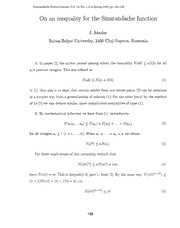
On an inequality for the Smarandache function PDF
Preview On an inequality for the Smarandache function
Smarandache Notions Journal, Vol. 10, No. 1-2-3, Spring 1999, pp. 126-128. On an inequality for the Smarandache function J. Sandor Bahe§-Bolyai University, 3.JOO Cluj-Napoca. Romania 1. In paper [2J the author proved among others the inequality S(ab) :::; as(b) for all a, b positive integers. This was refined to + S(ab) :::; S(a) S(b) (1) in [1 J. Our aim is to shmv that certain results from om recent paper [3] can be obtained in a simpler way from a generalization of relation (1). On the other hand, by the method of Le [lJ we can deduce similar, more complicated inequalities of type (1). 2. By mathematical induction we have from (1) immediately: (2) for all integers ai 2 1 (i = L ... , n). When al = ... = an = n we obtain (3) For three applications of this inequality. remark that S((m!t) :::; nS(m!) = nm (4) since S( m!) = m. This is inequality 3) part 1. from [3J. By the same way, S( (n!)(n-l)!) :::; (n - l)!S(n!) = (n - l)!n = n!, i.e. (5) 125 Inequality (5) has been obtain<~d in [3] by other arguments (see 4) part 1.). Finally, by 5(n2) ~. 25(n) ~ n for n even (see [3], ineqllality 1), n > 4, we have obtained a refinement of 5( n2) ~ n: (6) for n > 4, even. 3. Let m he a divisor of n. i.e. n = km. Then (1) gives 5(n) = 5(km) ~ 5(m) + 5(k), so we obtain: If min, then 5(n) - 5(m) ~ 5 (:) . (7) IT As an application of (7), let d( n) be the number of divisors of n. Since k = nd(n)/2, kin IT IT IT and k = n1 (see [3]), and by /.:1 k, from (7) we can deduce that k<n kin k<n (8) This improves our relation (10) from [3]. 4. Let 5(a) = u. 5(b) = v. Then blv1 and u!jx(x-l) ... (x-u+l) for all integers x ~ u. But from alu1 we have alx(x - 1) ... (x - u + 1) for all x ~ u. Let x = u + v + k (k ~ 1). Then. clearly ab( v+ 1) ... (v+k)l( u +v+k)!' so we have 5[ab( v+ 1) ... (v +k)] ~ u +v+k. Here v = 5(b), so we have obtained that 5[ab(S(b) + 1) ... (5(b) + k)] :::; 5(a) -+- 5(b) + k. (9) For example, for k = lone has 5[ab(5(b) + 1)] :::; 5(a) + 5(b) + 1. (10) + This is not a consequence of (2) for n = 3, since 5[5(b) 1] may be much larger than 1. 126 References [1] M. Le, An ineqTuzlity concerning the Smarandache junction, Smarandache Notions J., vol. 9(1998), 124-125. [2] J. Sandor, On certain inequalities involving the Smarandache junction, Smarandache Notions J., vol. 7(1996), 3-6. [3] J. Sandor. On certain new inequalities and limits jor the Smarandache junction, Smarandache Notions J., vol. 9(1998), 63-69. 127
